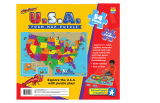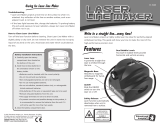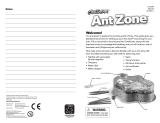Page is loading ...

©Educational Insights
www.educationalinsights.com
Be a Laser Detective
With your laser, you are a detective. Use it to discover the hidden superpowers of ordinary stuff.
Procedure:
1. Shine your laser onto the everyday household materials, one at a time. Some might behave in
extraordinary ways.
2. With the aluminum foil, try both the shiny and the dull sides. Then try crumpling up the foil.
3. Try the plastic wrap smooth and crumpled into a ball.
4. Does anything happen to the laser light when you pop the bubble wrap?
5. Try the laser very close to three narrow teeth of a comb and compare what you see with what
happens if the laser is farther away.
Results:
Different materials have different light properties. Some light will go through, some light will bounce off, some light will bend.
Because the laser is very focused light, it is easier to explore these optical (light) properties of different materials.
Materials:
• Laser
• Mirrors
• 10 Everyday
household materials
(such as paper,
sunglasses, plastic bags,
CDs or DVDs, paper
money, coins, bubble
wrap, cardboard, a
T-shirt, aluminum foil,
plastic wrap, wax paper,
facial tissue, a comb)
More Laser Fun:
Try a stack of paper plates. (Be sure to look on the back side of paper plates or cardboard to check for the laser light.) How
thick does something have to be to keep the laser from getting to the other side? How many paper plates does it take to
stop a laser beam? If the light shows up on the back of your stack, does it also keep going? Does it take the same number of
plates to stop light from a flashlight? What other ordinary items around the house can you try your laser on?
WARNING: Do not look directly at your laser. It could damage your eyes. Do not
shine your laser at anyone else. It could damage their eyes. Do not point laser at
moving vehicles as it can cause visual impairment. Adult supervision is suggested
for use of laser. This is a Class 1 laser.
Item Observations

©Educational Insights www.educationalinsights.com
Liquid Amazement
Let’s find out what happens when you shine your laser through liquids.
Procedure:
1. With the permission of a responsible adult, fill up three clear glasses with tap water.
2. Leave one alone. Add about 1 tablespoon of salt to the second. Add about 1 tablespoon of
sugar to the third. Mix the sugar in well with a spoon. Place ice cubes in the fourth glass.
Fill a fifth glass with olive or vegetable oil (use a small glass if you can, to save the oil).
3. Carefully take the glasses into a dark room and set them down.
4. Shine your laser beam into each of the glasses. Try from the side. Then try from the top.
5. Line up the glasses and try to shine your beam through each from the side.
6. Enjoy the show!
Results:
Light travels differently through different liquids. It scatters off particles suspended in those liquids. You should be able to see
the whole beam when you shine your light from the side through the oil and salt water. Different-sized oil molecules scatter the
light to reveal a tight beam. Undissolved particles in the salt water also scatter the light, producing a cloudy beam. You won’t
see a complete beam through the clear water or sugar water. There are fewer suspended particles to bounce back the light. But,
do you see any in the sugar water? How does the sugar water look different than the salt water? And what happens when you
shine your laser through the glasses from the top? What happens if you let the salty and sugary glasses sit for an hour and then
shine your light through?
Materials:
• Laser
• 3-5 Clear glasses
• 3 Cups of water
• 1 Tablespoon salt
• 1 Tablespoon sugar
• Olive or vegetable oil
• Tablespoon
• 1 Cup of ice cubes
• Measuring cup
More Laser Fun:
With the permission of a responsible adult, boil water and carefully pour it into a clear mug or clear measuring cup. Shine
your light through from the side and from the top. Compare with water at room temperature. Or, compare what you see when
you shine your laser through tap water with distilled water or mineral water. Or, try to mix and match water and oil in one glass.
Explore! Remember, these experiments work best in a dark room.
oil
sugar
water
salt
water
tap
water
ice
cubes

©Educational Insights www.educationalinsights.com
Through Glass
Lenses bend light. We use them to make images larger or smaller. What happens when a laser goes
through a lens?
Procedure:
Caution: Do not look at the laser through the glasses, magnifier, or binoculars. Only
aim the laser through these lenses away from yourself and others.
1. Aim your laser through a magnifying glass.
2. Compare what happens when you aim your laser through a family member’s prescription
eyeglasses (with their permission and when the glasses are not being worn.).
3. What does the star look like when you aim it through the magnifier?
4. Hold the binoculars away from you and aim the laser through them at a white surface. What
happens when you aim your laser through one end of a binoculars? Through the other end?
Results:
Binoculars magnify distant images because lenses focus light. Magnifying glasses and eyeglasses work the same way but
with a single lens instead of two. When you shine your laser through the small end of the binoculars, the laser light spreads out
when it comes out the larger end. Light that doesn’t pass through the lens will reflect the laser beam off the surface. Angling
the magnifying glass or eyeglasses so the laser light is bent by the sides of the lens rather than the middle will stretch the laser
point into a line of light in a similar way. In the dark, it may look like a robot is scanning your room from its eye slit!
Materials:
• Laser
• Magnifying glass
• Eyeglasses
• Binoculars
laser
laser
laser

©Educational Insights www.educationalinsights.com
Hidden Target
Have fun lighting up a hidden target. How many steps can you add to the laser light’s journey and
still light it up? How far away from the target can you be? This activity is best with a friend.
Procedure:
1. Place an old incandescent light bulb behind a bulletin board or other vertical barrier like a big
book. You might balance the bulb on an old cardboard tube or it can just be on the ground.
Be careful not to break the bulb. Keep your laser on the opposite side of the barrier.
2. Use the mirror to bounce the laser around the barrier and light up the bulb (see picture).
That would be one step between your laser and the target.
3. Create a pathway from your laser to the target using as many steps as you can. Can you use the diffraction grating?
The slides? Both? Try using an additional mirror.
4. How many different steps can you add? Can you keep all your steps on the laser’s side of the barrier?
Results:
The light bulb glows red because the laser light is reflected off the internal surface of the bulb and gets caught inside.
Can you use the diffraction grating to make more than one bulb glow? Photograph your setup or make a video of your trials.
light bulb
laser
bulletin board
mirror
Materials:
• Laser
• Incandescent light
bulb
(of a globe shape
only—see image at below
left)
• Mirrors
• Slides
• Diffraction grating
• Bulletin board or big
book

©Educational Insights www.educationalinsights.com
Amazing Laser Maze
Make your own plan to light up a glass of sugar water using what you’ve learned from the other
activities. Remember: To light up both the top and bottom surfaces of the glass like a prism*, the
laser light will have to shine on either the top or bottom of the glass, not just enter from the side.
You will have to think in three dimensions, not just two…
Procedure:
1. Place a glass of sugar water on a white surface behind a bulletin board or other big barrier
opposite your laser.
2. This time, tape your laser in place so you cannot move it at all, except to turn it on and off.
3. Without moving the glass of water, the barrier, or the laser, can you light up the glass of sugar water?
4. Try adding more obstacles between the laser and the glass. How far away can you be to light it up? Can you be in another
room? Turn out the lights and amaze your family and friends!
Draw your own setup here:
Results:
Draw your own diagrams to document your trials on your way to success! Photograph or make videos of your amazing
laser maze!
*You may substitute a prism for the glass of sugar water. Prism not included. A Discovery Prism can be purchased at www.educationalinsights.com;
search for item EI-5263.
Materials:
• Laser
• Bulletin board
or big book
• Tape
• Glass of sugar water
• Mirrors
• Diffraction grating
• Slides
• Other items of your
choosing
(some
ideas: cardboard tubes,
cardboard, adhesive
putty)
bulletin board
laser
sugar
water
/









